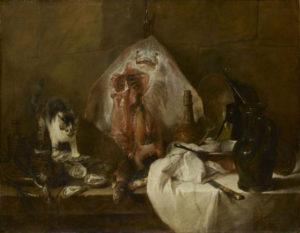Throughout his life, Jean-Simeon Chardin worked against the currents of his time. His century, the 18th, was dominated in France by artists such as Francois Boucher, known for his naughty bedroom scenes and Olympian fantasies.
Chardin was the complete opposite. Instead of imaginative concoctions, he painted the stuff sitting on the table: crockery, fruit, loaves, silverware, dead rabbits. Instead of movement, he aimed for stillness; instead of laughter, a kind of reverence. He was the antidote to the Rococo.

But Chardin wasn’t one of those tragic posthumous success stories, the rejected artist recognized for his genius only after his death. Despite being out of sync, he enjoyed success and steady patronage, and spent the last 10 years of his life (after Boucher’s death), as the first painter to the king, with an apartment in the Louvre.
He has enjoyed a solid position in art history ever since, inspiring modernists such as Manet and Cezanne, and, in his deep meditations on reality, recognized today as being ahead of his time, rather than out of step with it. He still suffers somewhat from the low status accorded to still life and genre painting in his time, even though our own time would seem to have transcended this older way of thinking.
How else to explain a wonderful show like “Chardin” – 66 works from all over the world – opening during the off-season at the Metropolitan Museum of Art, and slated to close Sept. 3, weeks before the serious season gets under way? Perhaps it’s just the vagaries of scheduling, as the exhibit has already made stops in Paris, Dusseldorf, and London, before landing here.
No matter. Take advantage of the lighter summer crowds at the Met and see what should be, in a just world, a blockbuster. Amazingly, this is the first Chardin show ever in New York, and the first in the United States in more than 20 years.
How many artists in the past several hundred years have taken this same assortment of cliched still life objects, carefully rendered highlight and shadow, contour and volume, and come up empty? How does Chardin make us interested in things like melons, fish, and dark wine bottles? Or, in a washerwoman at her tub, or a boy blowing bubbles?
He endows these subjects with an intensity and a feeling that makes them seem profound. Chardin was one of those artists who failed at the stylish thing, had to come to terms with a shortcoming in talent, and was forced to reach deeper into himself to compensate. He couldn’t paint scenes out of his head, and he wasn’t a wit with a brush, and so resolved to look harder at things than the painters before him.

His first still life triumph, “The Ray,” and the first painting to capture our attention in the show, is a strange and powerful picture, dominated by a disemboweled ray, hung upright so as to show the apparent “face” underneath. A cat tiptoes gingerly through opened oysters, while an assortment of dark objects – a jug, a ladle, a tub – coalesce on the right into the silhouette of a fanciful creature with an elephant’s trunk. The painting reads more stage scene than a still life, and Chardin seems intent on proving that his chosen genre was capable of as much narrative drama as any history painting.
Although he never again put together such an odd cast as this, he continued to make death a major presence in his work with the limp bodies of hares, rabbits, and partridges. Some sprawl across tables, some are hung up by their feet – but all of them are rendered so as to dramatize their absolute lifelessness, so that the real subject of the painting becomes the thing that is missing.
Given the large number of figures in this show, it seems unfair to call Chardin a still-life painter, except that the figures, reduced to basic geometries, seem to aspire to the stillness from which his objects strive to escape. They are frozen in time, but rescued from being porcelain statues by little tricks of animation: The boy building a house of cards barely breathes, but the cards, we know, can collapse in a second. The same principle holds true with the boy mesmerized by a spinning top, or the one whose bubble will shortly burst.
The women at their domestic chores – setting the table, addressing a child, scrubbing a frying pan with straw – are always caught in a slightly bent forward pose. Their posture suggests engagement with the task, but, because it’s a pose that can’t be held for long, it suggests imminent movement, and hence a time beyond the picture itself.
His subjects are rarely portraits, and it is less the specifics of character that Chardin looks for than some essential quality of simplicity or patience or goodness.
Chardin stopped doing genre paintings as he got older. They may have become too difficult for him – he never hid the struggle that went into his painting. Whatever the reason, he returned to still life in the last phase of his career, but without the dramatic tricks of his younger years. No slain rabbits, grotesque faces, or stalking cats. Just objects arranged on a table. A tall greenish jar of olives, a squat porcelain bowl, some half-emptied glasses of red wine, a fat loaf of bread, some ripe pears and apples, the thick edge of the table. A rosy light plays across the surfaces of the objects. Each thing is ordinary and yet beautiful and somehow conscious of being looked at. So there is this sense of an exchange taking place. Things exist to be taken in by our eyes, Chardin tells us. And we believe him.
The Metropolitan Museum of Art
2000

